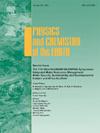Agricultural drought assessment using deep learning and multi-sensor remote sensing data integration
IF 3
3区 地球科学
Q2 GEOSCIENCES, MULTIDISCIPLINARY
引用次数: 0
Abstract
This study proposes a Deep Learning Multi-Layer Perceptron Neural Network (DLMLPNN) model-based Drought Index (DI), capable of handling large amounts of remotely sensed data from different sensors, for the Gaya district of South Bihar. Apart from Synthetic Aperture RADAR (SAR) data from Sentinel-1, the multispectral data from Sentinel-2 was to generate vegetation (NDVI) and moisture indices (NDMI) for the Gaya district in South Bihar. Further, rainfall data from the Tropical Rainfall Measuring Mission (TRMM) along with surface soil moisture data from the Soil Moisture Active Passive (SMAP) satellite, thermal data from Landsat-8 Operational Land Imager (OLI) and CH4 and O3 concentration data from Sentinel-5P are used. These remote sensing datasets were used as input for training the DLMLPNN to predict the Normalized Differential Moisture Index (NDMI) as an indicator of soil moisture. It was observed that the model estimated the NDMI with R2 statistics of 0.87 and 0.852 in the training and testing phases respectively. The NDMI gave a high correlation of more than 60 % with the ground collected Volumetric Soil Moisture (VSM). Feature Importance (FI) score was also computed to find out the contribution of each parameter used in the estimation of soil moisture. Based upon the weightage of each parameter used in the estimation of NDMI, a novel DI of the Gaya region was prepared for 2023. This index is the first of its kind for multi-sensor and multi-parameter drought analysis for the region and can be used to indicate drought conditions in other drought-prone areas.

基于深度学习和多传感器遥感数据集成的农业干旱评估
本研究提出了一种基于深度学习多层感知器神经网络(DLMLPNN)模型的干旱指数(DI),能够处理来自不同传感器的大量遥感数据,用于南比哈尔邦的Gaya地区。除了Sentinel-1的合成孔径雷达(SAR)数据外,Sentinel-2的多光谱数据用于生成比哈尔邦南部Gaya地区的植被(NDVI)和湿度指数(NDMI)。此外,还使用了热带降雨测量任务(TRMM)的降雨数据、土壤水分主动式被动卫星(SMAP)的地表土壤水分数据、Landsat-8业务陆地成像仪(OLI)的热数据以及Sentinel-5P的CH4和O3浓度数据。这些遥感数据集被用作训练DLMLPNN的输入,以预测归一化差分水分指数(NDMI)作为土壤水分的指标。在训练阶段和测试阶段,模型估计NDMI的R2统计量分别为0.87和0.852。NDMI与地面收集的体积土壤水分(VSM)具有60%以上的高相关性。并计算特征重要性(FI)分数,以找出各参数在土壤湿度估计中的贡献。根据NDMI估算中各参数的权重,编制了2023年Gaya地区的新DI。该指数首次用于该地区的多传感器、多参数干旱分析,可用于其他干旱易发地区的干旱状况指示。
本文章由计算机程序翻译,如有差异,请以英文原文为准。
求助全文
约1分钟内获得全文
求助全文
来源期刊

Physics and Chemistry of the Earth
地学-地球科学综合
CiteScore
5.40
自引率
2.70%
发文量
176
审稿时长
31.6 weeks
期刊介绍:
Physics and Chemistry of the Earth is an international interdisciplinary journal for the rapid publication of collections of refereed communications in separate thematic issues, either stemming from scientific meetings, or, especially compiled for the occasion. There is no restriction on the length of articles published in the journal. Physics and Chemistry of the Earth incorporates the separate Parts A, B and C which existed until the end of 2001.
Please note: the Editors are unable to consider submissions that are not invited or linked to a thematic issue. Please do not submit unsolicited papers.
The journal covers the following subject areas:
-Solid Earth and Geodesy:
(geology, geochemistry, tectonophysics, seismology, volcanology, palaeomagnetism and rock magnetism, electromagnetism and potential fields, marine and environmental geosciences as well as geodesy).
-Hydrology, Oceans and Atmosphere:
(hydrology and water resources research, engineering and management, oceanography and oceanic chemistry, shelf, sea, lake and river sciences, meteorology and atmospheric sciences incl. chemistry as well as climatology and glaciology).
-Solar-Terrestrial and Planetary Science:
(solar, heliospheric and solar-planetary sciences, geology, geophysics and atmospheric sciences of planets, satellites and small bodies as well as cosmochemistry and exobiology).
 求助内容:
求助内容: 应助结果提醒方式:
应助结果提醒方式:


